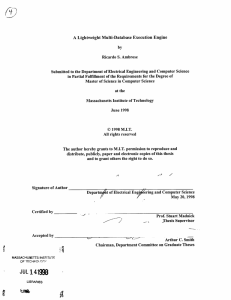16.7 Completing the Physical Query Plan
advertisement
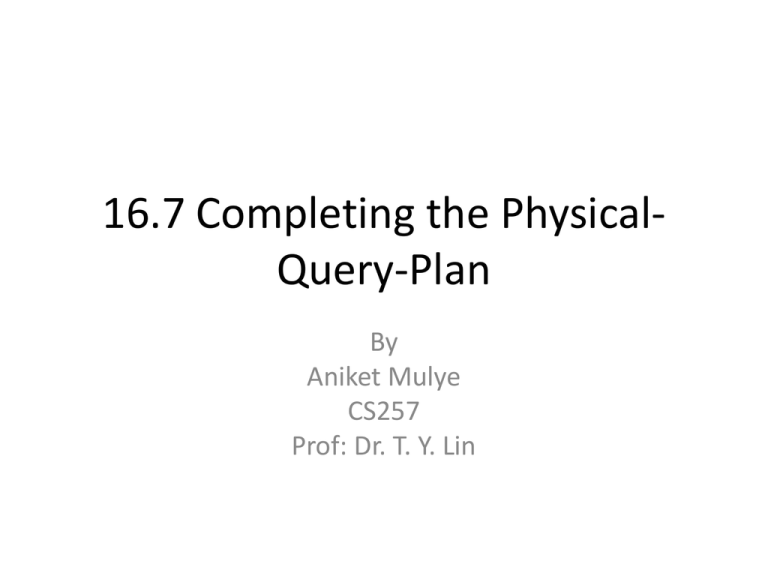
16.7 Completing the PhysicalQuery-Plan By Aniket Mulye CS257 Prof: Dr. T. Y. Lin Principal Issues • Selection of algorithms to implement the operations of the query plan, when algorithm-selection was not done as part of some earlier step such as selection of a join order by dynamic programming. • Decisions regarding when intermediate results will be materialized and when they will be pipelined. • Notation for physical-query-plan operators, which must include details regarding access methods for stored relations and algorithms for implementation of relational-algebra operators. Choosing a Selection Method • To pick algorithms for each selection operator. • Assuming there are no multidimensional indexes on several of the attributes, then each physical plan uses some number of attributes that each: – Have an index. – Are compared to a constant in one of the terms of the selection. • We then use these indexes to identify the sets of tuples that satisfy each of the conditions. Continued.. • We discuss physical plans that: – Use one comparison of the form AѲc, where A is an attribute with an index, c is a constant, and Ѳ is a comparison operator such as = or <. – Retrieve all tuples that satisfy the above comparison, using the index scan physical operator. – Consider each tuple selected above to decide whether it satisfies the rest of the selection condition. • We decide among the physical plans with which to implement a given election by estimating the cost of reading data for each possible option. • We shall count only the cost of accessing the data blocks, not the index blocks. Choosing a Join Method • One approach is to call for the one-pass join, hoping that the buffer manager can devote enough buffers to the join, or that the buffer manager can come close, so thrashing is not a major cost. • An alternative is to choose a nested-loop join, hoping that if the left argument cannot be granted enough buffers to fit in memory at once, then that argument will not have to be divided into too many pieces, and the resulting join will still be reasonably efficient. • A sort- join is good choice when either: – One or both arguments are already sorted on their join attributes – Or there are two or more joins on the same attribute, such as (R(a. b) w S(%c) ) w T(a,d ) When sorting R and S on a will cause the result of R w S to be sorted on a and used directly in a second sort-join Pipelining vs. Materialization • The naïve way to execute a query plan is to order the operations appropriately and store the results of each operation on disk until it is needed by another operation. This strategy is called materialization. • More subtle way to execute a query plan is to interleave the execution of several operations. The tuples produced by one operation are passed directly to the operation that uses it, without ever storing the intermediate tuples on disk. This approach in called pipelining. • Since pipelining saves disk I/O’s, where is an obvious advantage to pipelining, but there is a corresponding disadvantage. Since several operations must share main memory at any time, there is a chance that algorithm with higher disk I/O requirements must be chosen or thrashing will occur , thus giving back all the disk-I/O savings that were gained by pipelining. Pipelining Unary Operations • Selection and projection are excellent candidates for pipelining. Since these operations are tuple-at-a-time, we never need to have more than one block for input and one for output. Figure 1: Pipelining Binary Operations • We use one buffer to pass the results to its consumer, one block at a time. • The number of other buffers need to compute the results and to consume the results varies, depending on the size of the result and the sizes of other relations involved in the query. Notations for Physical Query Plans • Each operator of the logical plan becomes one or more operators of the physical plan, and leaves (stored relations) of the logical plan become, in the physical plan, one of the scan operators applied to that relation. • Materialization would be indicated by a Store operator applied to the intermediate result that is to be materialized, followed by a suitable scan operator when the materialized result is accessed by its consumer. • We shall indicate that a certain intermediate relation is materialized by a double line crossing the edge between that relation and its consumer. • All other edges are assumed to represent pipelining between the supplier and consumer of tuples. Operators for Leaves • Each relation R that is a leaf operand of the logical-query-plan tree will be replaced by a scan operator. • The options are: – TableScan(R): All blocks holding tuples of R are read in arbitrary order. – SortScan (R, L): Tuples of R are read in order, sorted according to the attribube(s) on list L. – IndexScan(R,C): Here, C is a condition of the form AѲc, where A is an attribute of R,Ѳ is a comparison such as = or <, and c is a constant. Tuples of R are accessed through an index on attribute A. If the comparison Ѳ is not =, then the index must be one, such as a B-tree, that supports range queries. – IndexScan(R,A): Here A is an attribute of R. The entire relation R is retrieved via an index on R.A. This operator behaves like TableScan, but may be more efficient in certain circumstances, if R is not clustered and/or its blocks are not easily found. Physical Operators for Selection • A logical operator σc(R) is often combined, or partially combined, with the access method for relation R, when R is a stored relation • Other selections, where the argument is not a stored relation or an appropriate index is not available, will be replaced by the corresponding physical operator we have called Filter. • The notation we shall use for the various selection implementations are: – We may simply replace σc (R) by the operator Filter(C). – If condition C can be expressed as AѲc AND D for some other condition D, and there is an index on R.A, then we may: • Use the operator InterScan(R,Aѳc) to access R, and • Use Filter(D) in place of the selection σc (R). Physical Sort Operators • Sorting of a relation can occur at any point in the physical query plan. • When we apply a sort-based algorithm for operations such as join or grouping, there is an initial phase in which we sort the argument according to some list of attributes • It is common to use an explicit physical operator Sort(L) to perform this sort on an operand relation that is not stored. Other Relational Algebra Operations • All other operations are replaced by a suitable physical operator. • These operators can be given designations that indicate: – The operation being performed, e.g., join or grouping. – Necessary parameters, e.g., the condition in a theta-join or the list of elements in a grouping. – A general strategy for the algorithm: sort-based, hashbased, or in some joins, index-based. – The decision about the number of passes to be used: onepass, two-pass, or multi-pass – An anticipated number of buffers the operation will require. Ordering of Physical Operations • The following rules summarize the ordering of events implicit in a physical-query-plan tree: • Break the tree into sub-trees at each edge that represents materialization. The sub-trees will be executed one-at-a-time. • Order the execution of the sub-trees in a bottom-up, left-to-right manner. To be precise, perform a preorder traversal of the entire tree. Order the sub-trees in the order in which the preorder traversal exits from the sub-trees. • Execute all nodes of each sub-tree using a network of iterators. Thus, all the nodes in one sub-tree are executed simultaneously, with GetNext calls among their operators determining the exact order of events. • Following this strategy, the query optimizer can now generate executable code, perhaps a sequence of function calls, for the query. References • Database Systems: The Complete Book by Hector Garcia-Molina, Jeffrey D. Ullman, Jennifer Widom. Thank You

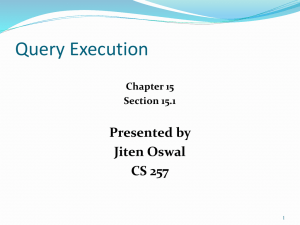

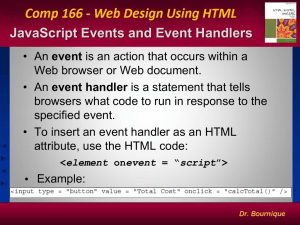

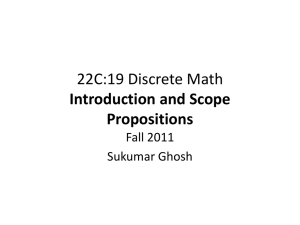

![Charul_Saxena_ID_201_Lecture_Notes[1]](http://s2.studylib.net/store/data/005640284_1-b2650585c899027ad372bbf133657f58-300x300.png)
